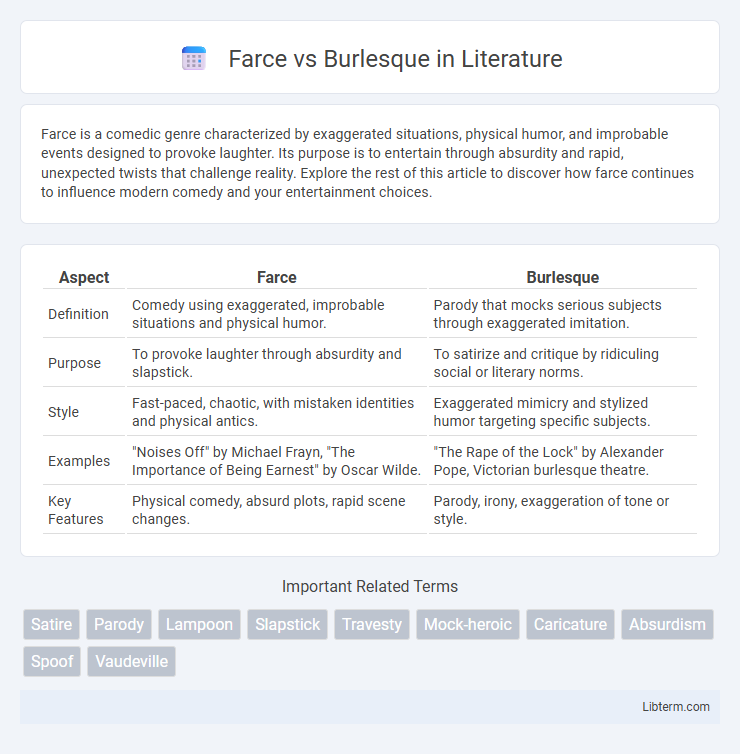Farce is a comedic genre characterized by exaggerated situations, physical humor, and improbable events designed to provoke laughter. Its purpose is to entertain through absurdity and rapid, unexpected twists that challenge reality. Explore the rest of this article to discover how farce continues to influence modern comedy and your entertainment choices.
Table of Comparison
| Aspect | Farce | Burlesque |
|---|---|---|
| Definition | Comedy using exaggerated, improbable situations and physical humor. | Parody that mocks serious subjects through exaggerated imitation. |
| Purpose | To provoke laughter through absurdity and slapstick. | To satirize and critique by ridiculing social or literary norms. |
| Style | Fast-paced, chaotic, with mistaken identities and physical antics. | Exaggerated mimicry and stylized humor targeting specific subjects. |
| Examples | "Noises Off" by Michael Frayn, "The Importance of Being Earnest" by Oscar Wilde. | "The Rape of the Lock" by Alexander Pope, Victorian burlesque theatre. |
| Key Features | Physical comedy, absurd plots, rapid scene changes. | Parody, irony, exaggeration of tone or style. |
Introduction to Farce and Burlesque
Farce is a comedic genre characterized by exaggerated situations, physical humor, and rapid-paced plotlines designed to provoke laughter through absurdity. Burlesque combines theatrical parody and satire, often using exaggerated mimicry to mock serious subjects or societal norms. Both genres emphasize humor but differ in style; farce relies on slapstick and improbable scenarios, while burlesque employs wit and theatrical exaggeration.
Defining Farce: Key Elements
Farce is a comedic genre characterized by exaggerated situations, physical humor, and improbable events that create rapid-paced, absurd scenarios. Key elements include slapstick comedy, mistaken identities, and improbable coincidences designed to provoke laughter through chaos and exaggeration. The emphasis lies on timing, visual gags, and absurd dialogues that strip away realistic constraints for maximum comedic effect.
Burlesque Explained: Characteristics and Style
Burlesque is a theatrical genre characterized by exaggerated parody, humorous imitation, and often risque performance, blending elements of satire and dance. It employs stylized costumes, comedic timing, and provocative choreography to entertain while critiquing social norms. Rooted in 17th-century origins, burlesque evolved to emphasize striptease, slapstick humor, and cabaret-style acts that prioritize spectacle and playful subversion.
Historical Origins of Farce
Farce originated in medieval Europe during the 12th century as a form of comedic theater characterized by exaggerated, improbable situations and physical humor. It developed from short, humorous interludes called "farces" inserted into more serious liturgical dramas, evolving into standalone performances by the 15th century. This genre influenced later theatrical forms by emphasizing slapstick comedy, mistaken identities, and rapid-paced plot twists.
The Evolution of Burlesque
Burlesque evolved from early 17th-century parody and exaggerated theatrical performances, distinct from the fast-paced, physical humor of farce. Over time, burlesque incorporated music, dance, and satire, becoming a blend of comedic and variety acts that challenged social norms and entertained diverse audiences. This evolution highlighted burlesque's adaptability, transforming from highbrow theatrical critique into a popular form celebrating spectacle and risque performance.
Comparing Themes: Farce vs Burlesque
Farce emphasizes exaggerated, improbable situations and physical humor to highlight absurdity in everyday life, often focusing on mistaken identities and slapstick comedy. Burlesque, in contrast, parodies serious subjects such as classical literature, politics, or social norms through caricature and satire, using exaggeration to mock rather than simply entertain. While farce relies on fast-paced, chaotic plots to provoke laughter, burlesque employs wit and irony to critique cultural or artistic conventions.
Performance Techniques in Both Genres
Farce relies on exaggerated physical comedy, rapid pacing, and improbable situations to provoke laughter, emphasizing slapstick and visual gags in its performance techniques. Burlesque combines parody, satire, and sensual dance, using elaborate costumes and musical elements to entertain while often mocking serious subjects. Both genres exploit exaggeration, but farce focuses on absurdity and timing, whereas burlesque highlights theatricality and audience engagement through provocative humor.
Cultural Impact and Influence
Farce and burlesque have shaped cultural narratives by offering distinct modes of satire and social commentary, with farce using exaggerated, improbable situations to challenge societal norms and burlesque employing parody and theatrical spectacle to subvert established genres. Farce's rapid-paced humor and physical comedy influenced modern sitcoms and slapstick, while burlesque deeply impacted performance art, music hall traditions, and the evolution of American variety shows. Both forms continue to inspire contemporary media, reflecting cultural tensions through humor and performance styles that resonate across generations.
Famous Works in Farce and Burlesque
Farce is exemplified by works such as "Noises Off" by Michael Frayn and "The Importance of Being Earnest" by Oscar Wilde, known for their fast-paced, exaggerated scenarios and physical humor. Burlesque includes famous performances like the satirical musical "Little Shop of Horrors" by Howard Ashman and Alan Menken and the comedic sketches of the "Vaudeville" era, characterized by parody and over-the-top mimicry. Both genres rely on humor but farce focuses on improbable situations while burlesque emphasizes parody and satire of established works.
Farce vs Burlesque: Which Resonates Today?
Farce and burlesque both use exaggeration and humor but differ in style and intent; farce relies on slapstick, improbable situations, and fast-paced action, while burlesque blends parody with theatrical elements, often incorporating satire and performance art. Today, farce resonates with audiences through its universal appeal to physical comedy and absurdity, making it accessible across cultures and generations. Burlesque continues to captivate with its bold, provocative performances and social commentary, appealing particularly to those interested in both entertainment and critique of societal norms.
Farce Infographic

 libterm.com
libterm.com